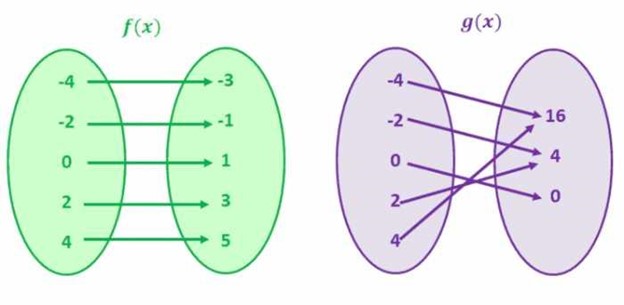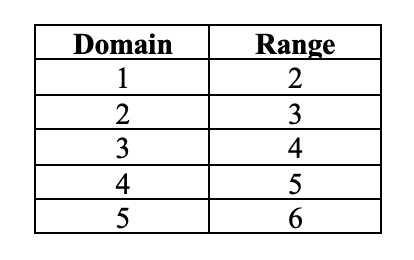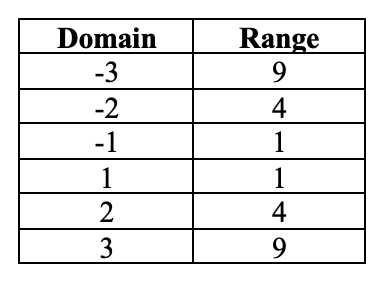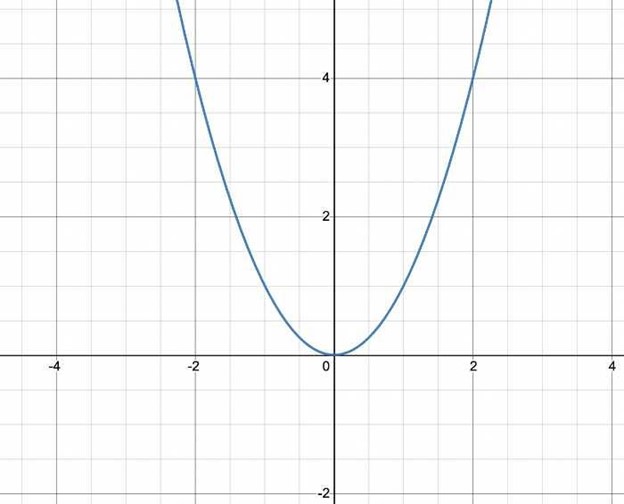One to One Functions - Graph, Examples | Horizontal Line Test
What is a One to One Function?
A one-to-one function is a mathematical function whereby each input corresponds to just one output. That is to say, for each x, there is a single y and vice versa. This means that the graph of a one-to-one function will never intersect.
The input value in a one-to-one function is noted as the domain of the function, and the output value is the range of the function.
Let's study the examples below:

For f(x), each value in the left circle correlates to a unique value in the right circle. In conjunction, any value in the right circle corresponds to a unique value in the left circle. In mathematical terms, this implies every domain owns a unique range, and every range holds a unique domain. Thus, this is an example of a one-to-one function.
Here are some different examples of one-to-one functions:
-
f(x) = x + 1
-
f(x) = 2x
Now let's examine the second picture, which displays the values for g(x).
Notice that the inputs in the left circle (domain) do not own unique outputs in the right circle (range). Case in point, the inputs -2 and 2 have equal output, in other words, 4. In the same manner, the inputs -4 and 4 have equal output, i.e., 16. We can discern that there are equivalent Y values for numerous X values. Hence, this is not a one-to-one function.
Here are some other representations of non one-to-one functions:
-
f(x) = x^2
-
f(x)=(x+2)^2
What are the qualities of One to One Functions?
One-to-one functions have these properties:
-
The function holds an inverse.
-
The graph of the function is a line that does not intersect itself.
-
They pass the horizontal line test.
-
The graph of a function and its inverse are the same with respect to the line y = x.
How to Graph a One to One Function
When trying to graph a one-to-one function, you are required to determine the domain and range for the function. Let's examine an easy representation of a function f(x) = x + 1.

As soon as you possess the domain and the range for the function, you ought to chart the domain values on the X-axis and range values on the Y-axis.
How can you determine whether or not a Function is One to One?
To indicate whether a function is one-to-one, we can leverage the horizontal line test. Immediately after you graph the graph of a function, trace horizontal lines over the graph. In the event that a horizontal line intersects the graph of the function at more than one place, then the function is not one-to-one.
Due to the fact that the graph of every linear function is a straight line, and a horizontal line does not intersect the graph at more than one point, we can also conclude all linear functions are one-to-one functions. Keep in mind that we do not leverage the vertical line test for one-to-one functions.
Let's examine the graph for f(x) = x + 1. Immediately after you chart the values of x-coordinates and y-coordinates, you ought to consider whether or not a horizontal line intersects the graph at more than one place. In this case, the graph does not intersect any horizontal line more than once. This indicates that the function is a one-to-one function.

On the other hand, if the function is not a one-to-one function, it will intersect the same horizontal line multiple times. Let's study the diagram for the f(y) = y^2. Here are the domain and the range values for the function:

Here is the graph for the function:

In this instance, the graph crosses numerous horizontal lines. For example, for both domains -1 and 1, the range is 1. Similarly, for both -2 and 2, the range is 4. This signifies that f(x) = x^2 is not a one-to-one function.
What is the inverse of a One-to-One Function?
Since a one-to-one function has only one input value for each output value, the inverse of a one-to-one function also happens to be a one-to-one function. The inverse of the function essentially undoes the function.
For example, in the example of f(x) = x + 1, we add 1 to each value of x in order to get the output, or y. The opposite of this function will deduct 1 from each value of y.
The inverse of the function is f−1.
What are the properties of the inverse of a One to One Function?
The qualities of an inverse one-to-one function are identical to all other one-to-one functions. This means that the inverse of a one-to-one function will possess one domain for each range and pass the horizontal line test.
How do you figure out the inverse of a One-to-One Function?
Finding the inverse of a function is not difficult. You simply need to swap the x and y values. Case in point, the inverse of the function f(x) = x + 5 is f-1(x) = x - 5.

Just like we discussed before, the inverse of a one-to-one function reverses the function. Since the original output value showed us we needed to add 5 to each input value, the new output value will require us to deduct 5 from each input value.
One to One Function Practice Examples
Examine these functions:
-
f(x) = x + 1
-
f(x) = 2x
-
f(x) = x2
-
f(x) = 3x - 2
-
f(x) = |x|
-
g(x) = 2x + 1
-
h(x) = x/2 - 1
-
j(x) = √x
-
k(x) = (x + 2)/(x - 2)
-
l(x) = 3√x
-
m(x) = 5 - x
For every function:
1. Figure out whether or not the function is one-to-one.
2. Chart the function and its inverse.
3. Find the inverse of the function numerically.
4. Indicate the domain and range of every function and its inverse.
5. Use the inverse to solve for x in each equation.
Grade Potential Can Help You Master You Functions
If you happen to be facing difficulties trying to understand one-to-one functions or similar topics, Grade Potential can set you up with a one on one teacher who can support you. Our Sacramento math tutors are skilled professionals who support students just like you improve their mastery of these types of functions.
With Grade Potential, you can work at your unique pace from the comfort of your own home. Book a meeting with Grade Potential today by calling (916) 354-6383 to learn more about our teaching services. One of our representatives will contact you to better inquire about your needs to provide you with the best teacher for you!




